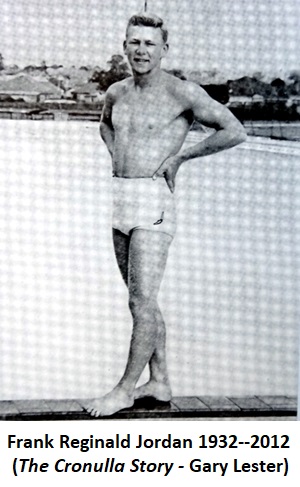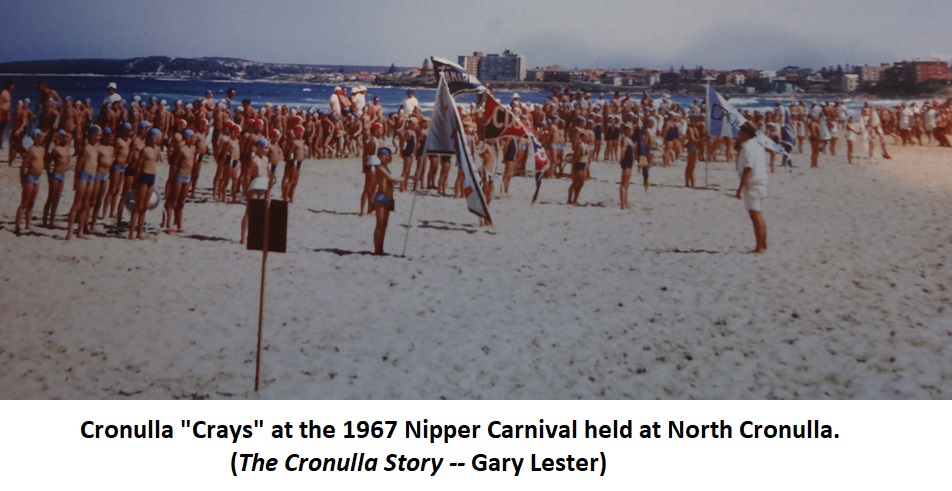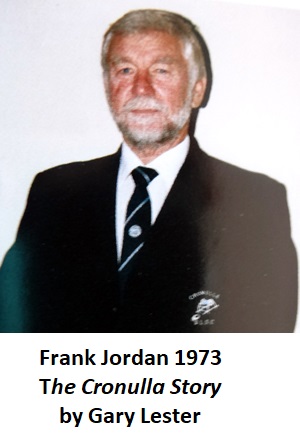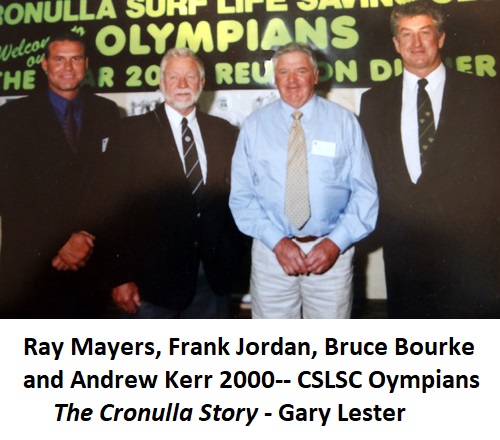
FRANK REGINALD
JORDON, (1932-2012)

Olympian Coach – Water Polo
Life Member Cronulla SLSC
Father of Water Polo in the Sutherland Shire
Frank Reginald Jordan
was born in Bankstown, NSW, on 19 August 1932. He was
the son of Arthur Henry Jordan (1905-1964) and his wife, Emily Ada nee Treleaven
(1905-1981). There were two other children in the family – Leonard and Norma.
Frank
was educated at Homebush High School and during 1951-1953 was a student at
Sydney Teachers’ College (STC) where he trained to be a Physical Education
teacher with the NSW Department of Education. He later achieved a Bachelor of
Arts degree from University of New England and a Master of Education from Sydney
University.
After
graduating from Sydney Teachers’ College, Frank was appointed to Newtown High
School and then to Sydney Technical High School at Hurstville.
In 1968 he was appointed as a lecturer at Sydney Teachers’ College and
from 1976 to his retirement in 1991 was Senior Lecturer in Occupational Therapy
at the Cumberland College campus of Sydney University.
In
March 1948, representing Homebush High School, Frank Jordan won the 220 yards
Junior Final at the All Schools Swimming Championships at North Sydney Olympic
Pool. He set a new record for the event and running second was Max Riddington.
In later years, representing Cronulla SLSC and Manly SLSC, they would clash in
events at many surf carnivals.
In
February 1949 at the NSW Championships, in the 440 yards freestyle event, Frank
Jordan ran second to the Victorian Olympic swimmer John Marshall, who set a new
record time of 4 mins.48.1 seconds. As a visitor, Marshall could not hold the
title which went to Jordan from Bankstown Amateur Swimming Club. There was an
exciting race in the 880 yards freestyle event which was won by Frank Jordan.
On
15 March1949 the Combined High Schools Swimming Championships were held with
over 500 boys from metropolitan and country high schools competing.
Frank Jordan and Don Talbot were mentioned in newspapers as star swimmers
from Homebush High. At the meet Frank won the 880 yards event. During the 1949
season he competed in senior championship races and many club and school events.
Trained by Frank Guthrie at Bankstown pool he dropped out of the 1,500 metres
swimming championship at Bankstown citing strain from his heavy schedule.
In
February1950 competing in the NSW 440 yards championship, Frank finished in
third position behind Garrick Agnew and Frank O’Neill. Agnew set a new
Australian record which was 3.9 seconds better than the Empire Games record he
had set the previous week in Auckland. In March 1950, at Balmain, Frank Jordan
took 3-10s. off Moss Christie’s 220 yards freestyle record which had stood for
19 years. The swim wound up his preparation for a NSW v Canada match at North
Sydney. This was also the last year of high school for Frank and studying for
the Leaving Certificate at the end of the year assumed more importance. His
efforts paid off and he gained entrance to the highly selective Physical
Education section at Sydney Teachers’ College.
In
December 1951 the NSW Swimming Association decided to protest against a ruling
by F.I.N.A., which controlled amateur swimming, that all physical education
teachers were professionals. This was a time when the Olympic Games were
strictly for amateur competitors. Among the swimmers affected by such a ruling
were Frank Jordan, Don Talbot, Bill Brady and Australian junior surf champion
John Bloomfield who were in contention for Games selection. All were training as
Physical Education teachers at Teachers’ College before qualifying for a
position with the Education Department. New Zealand had similar concerns about
some of their athletes. At the time of selection for the 1948 Olympic Games
similar concerns had been raised about Australians Peter Mullins and Joyce King.
In 1947 Peter Mullins was Physical Education teacher and field coach at Kogarah
Intermediate High School. Joyce King was a teacher at Willoughby Domestic
Science School. Fortunately, the situation was resolved.
In
January 1952 the NSW water polo team to play against Melbourne was announced.
Frank Jordan was one of the five Balmain players chosen in the team. In the late
forties/early fiifties water polo was introduced in High schools in the
metropolitan area where there was a strong following. Eight schools played in
each of the two grades of the competition. Matches were held at Balmain and
Rushcutters Bay baths and were played parallel with the cricket season. North
Sydney Technical High School had won or shared the premiership in 1946/7/8 but
in 1949 Homebush High took the title from them. It is highly likely that Frank
Jordan and Don Talbot were in that team. Both were trained at Bankstown pool by
Frank Guthrie, a former state representative in water polo.
In
1952 the Olympic Games were to take place in Helsinki, Finland and in 1956 would
be held in Melbourne. The Australian Olympic Federation (AOF) was anxious that
Australia be represented at Helsinki by teams representing every international
sport played in the country and that the teams were accompanied by a contingent
of officials who would, on return, be able to offer valuable insights and advice
to the organisers of the Melbourne Games. A major problem was funding the team
as government grants totalled only £30,000 with an extra £100,000 needing to be
raised by the states and sporting bodies.
In
March the AOF approved a team of thirty five competitors and five officials.
Members of the team came from swimming, athletics, cycling, boxing, wrestling,
yachting, weight-lifting, fencing and sculling. It was also announced that when
further funds were available the travelling expenses of other competitors who
had just missed out on selection, including five rowers and four water polo
players, would be added to the list. All sporting bodies with representatives at
the Games would be asked to raise funds. The NSW Rowing Association was
particularly bitter about the omission of the rowing eight which had a good
chance of winning at the Games. Their protest was justified when, at the Games,
the ‘eight’ came third in the final of their event and returned to Australia
with a bronze medal.
On
19 March the Secretary of the NSW State Olympic Council S.B.Berge, announced
that many thousands of pounds would be required to ensure selection of nineteen
NSW athletes who were on the brink of making the team. Firms and sporting groups
like the Greyhound Breeders, Owners’ and Trainers Association, responded and
fund raising events were organised. The rowing crew gave an exhibition row at
the Newington Regatta. The Bankstown Swimming Club opened a fund for Frank
Jordan which was boosted by a donation from the Bankstown Trotting Club’s
gymkhana.
By
2 April, six weeks before the first group was due to leave, the make up of the
Australian team was still uncertain with more nominations being received. There
was still some doubt about finance and travel arrangements were in confusion.
The two planes chartered for the team to leave on 10 June and 14 June would not
accommodate the extra numbers and other arrangements would have to be made. Some
competitors were already overseas and the water polo team and members of the
fencing team were travelling by boat. Return ship bookings for the main team had
been cancelled because of the uncertainty and the team would have to fly back.
The team would have to leave three days after the Games ended and any competitor
wanting to stay on would do so at their own expense and have to pay their own
return fare to Australia. At nineteen,
Frank was the youngest member of the water polo team. His team-mate from
Balmain, Anthony (Tony) Fenech was also in the team.
David and Frank were both students at Sydney Teachers’ College and on
their return would address the student body in the Great Hall and describe their
experiences.
Leaving
Australia aboard the liner Strathmore,
the water polo team had received guarantees for matches at Colombo, Bombay,
Florence, Rome, Hamburg and British cities. Before the Games the team was based
in Italy and played games against some of the top teams. They then travelled to
England and gained further experience playing against local teams.
Unfortunately, at the Games, they came up against the strong European teams and
in their first game against Yugoslavia lost 10-2. They were eliminated after
their second game when defeated by Austria 6-0. The results of the competition
were gold to Hungary, silver to Yugoslavia and bronze to Italy.
Before returning to Australia, the team returned to England and played a
series of games against top club sides with mixed results. They won a game
against a North England side at Lancaster 10-3 and Frank Jordan scored a goal.
Even though the team did not do well at the Games it was felt that the
experience of playing in England and on the Continent and the knowledge gained
would be an asset in future years. On 28 August 1952 Frank Jordan, with
team-mates Tony Fenech, Doug Laing, James O’Doherty, Ray Smee and Keith
Whitehead, left London on board the P&O liner
Strathaird to return home.
On arrival back in Sydney, he resumed his studies at STC. After their
return, members of the team commented on the ‘swim fast and fast pass’
tactics of teams they had encountered and that local umpires should not
tolerate the ‘bash and grapple’ tactics that
some teams used. The foresight of the Association in planning the Olympic
campaign paid off and water polo in Australia improved.
In
1940 Frank Guthrie, Jordan’s coach at Bankstown Club, joined Cronulla Surf Life
Saving Club. He accepted the position of honorary swimming coach of the surf
club and in the 1950-51 and 1953-54 seasons persuaded sixteen Bankstown swim
members join the club. Prominent in the group from Bankstown was Frank Jordan
who won the Cronulla club’s senior belt and senior surf championships in
1951-52. He repeated that success in
1952-53 and 1953-54 becoming the first member to win those events three years in
succession. At the Australian surf championships at North Wollongong in March
1952, Frank won the senior surf (non-championship) event which attracted a field
of two hundred and eighty starters.
This event was contested for the Roy Doyle Memorial Reel which was awarded to
the winner’s club. The late Roy Doyle (Tamarama and Freshwater) was one of the
pioneers of the Australian Surf Life
Association.
In
surf carnivals in the 1952-3 season, Frank won eight successive senior belt
races at metropolitan carnivals and also competed in senior surf races where one
of his toughest rivals was Max Riddington from the Manly club, his former rival
in the pool and Australian surf champion, a flat sea suiting them both better
than a big surf. Newspapers, reporting before
the carnivals noted that Jordan would have little opposition in the belt races
but face stiff competition in the surf events. After having such an outstanding
season Frank was beaten in the metropolitan championships at Bondi as his line
was fouled when he had a commanding lead. Unfortunately this was the qualifying
event for the national championships.
In
November 1953 Frank Jordan’s unusual training routine for the coming season
attracted a lot of interest. He planned to don a surf belt, tie the line to a
rail and swim, without moving, for 20 minutes each day.
Overseas swimmers had given him the idea of which he said
’20 minutes on the line takes the same
energy needed to swim about one and a half miles’.
After six weeks of this he would then be fit and swim three miles a day
until the championships in March. He hoped to represent Australia in Tests
against New Zealand in February. Unfortunately the 1953-54 season was not as
successful as previous ones. He was
not chosen in the Australian team which won against New Zealand at the Royal
Carnival at Bondi on 6 February, was unplaced in the Senior Belt at the same
event and finished fourth in the Metropolitan championships at Coogee on 27
February 1954. Jordan announced that this was his last year in competitive sport
and that it was his intention to concentrate on his career, coach schoolboy
swimmers and introduce water polo to junior technical schools.
It was in his role as a coach that Frank Jordan would
become one of the major influences in the success of the Cronulla
Surf Club
in the following decades. In the 40’s and 50’s potential swimmers in the Shire
were disadvantaged by their training facilities. There were pools at the beach
and the baths at Gunnamatta Bay where Guthrie and now Jordan trained and taught
swimmers. There were also netted enclosures in some of the other bays in the
Shire.
Appointed
by Cronulla to succeed Guthrie as club coach, Jordan had concentrated on
developing still-water swimmers as coach of the Cronulla Amateur Swimming Club
at Gunnamatta Baths, bringing modern attitudes to training and competition,
building on the team spirit and competitive nature of the club’s members. In
Gary Lester’s history The Cronulla Story, Jordan regretted that he had not introduced surf
training for the surf club members of his squad but, motivated by the new
techniques, they increased their training distances which improved standards at
the club overall. He coached all five members of the surf teams group who were
all sub-five-minute-quarter swimmers and went on to win the national title in
1963 – Barry Ezzy, Ian Thomson, Alan Wood, Ron Greenaway and Graham Elliott. For
many years, these names would be prominent at Club, Sydney Branch, State and
Australian championship events.
As well as coaching swimmers Jordan trained the R & R
teams and oversaw the rise of the Cronulla SLSC as one of the most competitive,
successful and well administered clubs in the surf life saving movement. In
1967-68 he was Deputy President and Secretary of the club. By 1967 Jordan had
decided to retire from professional swim coaching and joined Sydney Teachers’
College as a lecturer.
As
the Nipper movement grew, Cronulla was protective of the younger members of the
club, known as Cronulla Crays. Frank Jordan was part of a three-man
sub-committee which organised and oversaw training schedules, coaching classes,
interclub carnivals and trips away.

In 1988-89, the Cronulla club needed to change their
constitution before becoming incorporated. A special committee, with Frank
Jordan as convenor, Ken English, Harold Spurway and Ron Simmons, was set up to
prepare the new document. Frank was involved in surf club management and policy
until 2011.
In
1963 Frank Jordan convened a meeting at Cronulla Surf Club with the intention of
forming a water polo club that would allow local players to become eligible for
selection in state, national and Olympic teams.
From the 1930’s teams from the Shire had competed in the St.George
district competition with many members coming from the local surf clubs. This
was a big step forward.
Teams
from Gymea Bay and Cronulla Surf Club were merged and entered in the Third
Division of the Sydney Metropolitan Competition. This was the beginning of one
of the most successful water polo clubs in Australia. In 1964, the club was
formed as the St.George and Sutherland Shire Amateur Water Polo Club and in 1970
changed its name to Cronulla-Sutherland Water Polo Club becoming an affiliate of
the Sharks Rugby League Club. It is
now known in the National Water Polo League as Cronulla Sharks Water Polo Club
and since 1976 has provided many Olympic representatives in both men’s and
women’s teams.
In 1968-69 the first ladies team was entered in the
competition and won the club’s first title and first 1st Grade
Premiership. This was the first of many titles but perhaps the most important
element in their subsequent success was the way their coaches and administrators
nurtured their junior players. In the 1960’s and 1970’s all high schools had
competitive programs and leading the way was Cronulla High School. Doug Lyons, a
1st Grade player with the club and science teacher at the school,
became a role model and helped set the standard, offering the best learning and
development pathways possible. As part of the Bluestone Property Development in
the area, a water polo facility was to be constructed at Cronulla High School
and be available to the public. The programs and involvement at high school
level reflects Frank Jordan’s statement when he retired from competition.
Personal Life:
On 14 May, 1955, at the Methodist Church, Surf Road,
Cronulla, Frank Jordan married Shirley Joyce Dixon (Reg.No.11198).
Shirley, born at St.Mary’s, NSW, on 21 October,1934, was the daughter of
Frank Woodhouse Dixon (1906-1967) and his wife, Joyce Irene (d.1999) nee Moore.
Frank and Joyce Dixon were married at Penrith in 1932. They also had a son
Nicholas (1933-1998) who was a stalwart of Cronulla SLSC.
After
their marriage, Frank and Shirley Jordan lived at Miranda and later at Cronulla.
They had three children - Robyn, David and Jennifer. Frank was a devoted family
man and had a strong involvement with his eight grandchildren.
He
had a keen interest in intellectual pursuits and discussion and this was well
known amongst his acquaintances. In 1999-2000, he was involved in the community
consultation re the sewerage outfall project. He enjoyed camping and was still
swimming until illness forced him to stop in 2011.

In 1973, Frank Jordan received Life Membership of the
Cronulla club in recognition of his contribution to the club as a competitor,
coach and administrator. He received a 50 Year Long Service Award from Surf Life
Saving Australia. In May 2000, he and other Club Olympians were guests of honour
at a celebratory dinner held at the Clubhouse. With him were Ray Mayers – water
polo 1984, 1988, 1992; Bruce Bourke – swimming 1948; Andrew Kerr – water polo
1976, 1980, 1984, 1988.

In 1988, Frank Jordan was inducted into the Bankstown
Sporting Hall of Fame.
Frank
Jordan died on 13 March, 2012 and was cremated at Woronora Cemetery.
Shirley Jordan died on 21 August, 2015 and was cremated
at Woronora Cemetery.
Water polo and the surf
life saving movement certainly owe a debt of gratitude to a dedicated
competitor, teacher, coach, and administrator who paved the way for success for
so many at State, National and International level.
Colleen Passfield
2018
Click
on the name
FRANK REGINALD JORDON (1932-2012)
at the heading of this story. You will be taken to the database entry for Frank
Jordan and his family.
REFERENCES:
-
Dr.Robyn Jordan
-
NSW BDM
-
Wikipedia
-
Australian Dictionary of Biography
-
International Swimming Hall of Fame
-
The Cronulla Story
by Gary Lester
-
Building Strong Traditions
by Faye M. Young
-
Bankstown Sporting Hall of Fame
-
Cronulla Sharks Water Polo Club
-
A Brief History of Cronulla Sutherland Water
Polo by John Watkins
-
Cronulla Swim Club (previously Cronulla Amateur
Swimming Club
-
UK, Outward Passenger Lists, 1890-1960
-
Woronora Cemetery records
-
Personal knowledge
-
Trove
-
Newspapers:
-
The Sun (Sydney,NSW)
-13 Mar 1948,14 Mar 1948, 13 Feb 1949, 11 Jan 1953, 18 Jan 1953, 25 Nov
1953, 6 Feb 1954, 8 Feb 1954
-
The Sunday Herald (Sydney, NSW)
- 13 Feb 1949, 13 Mar 1949, 10 Apr 1949, 9 Apr 1952, 28 Feb 1954
-
The Sydney Morning Herald (NSW)
– 16 Mar 1949,24 Mar 1949, 19 Nov1949, 8 Mar 1950, 21 Dec 1951, 19 Mar 1952,
29 Jan 1953, 2 Dec 1953, 8 Feb 1954
-
The Daily Telegraph (Sydney, NSW)
– 12 Mar 1949, 8 Mar 1950, 5 May 1952, 24 Aug 1952, 29 Jan 1953, 8 Feb 1954,
28 Feb 1954
-
Truth (Sydney, NSW)
– 1 Feb 1953
Daily Examiner (Grafton,NSW) – 7 Feb 1949
-
Daily Advertiser (Wagga Wagga, NSW)
–28 Feb 1949, 20 Feb 1950
-
Illawarra Daily Mercury (Wollongong, NSW)
– 10 Mar 1952,




